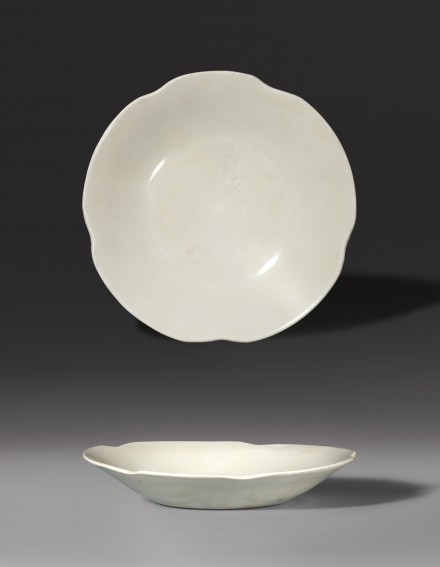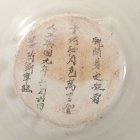J.J. Lally & Co., Oriental Art / New York City, New York
MenuPast Exhibition
EARLY CHINESE WHITE WARES
The Ronald W. Longsdorf Collection
September 11 - October 3, 2015

21.
AN INSCRIBED FLOWER-SHAPED DISH
Early Northern Song Dynasty, A.D. 10th Century
Ding kilns
with gently rounded sides flaring out from a slightly concave center to a knife-pared rim divided into five simple petal-lobes by wide shallow notches, covered inside and out with an ivory-tinted clear glaze showing slightly darker ‘tear marks’ on the underside and ending unevenly around the angle of the flat unglazed base, the exposed surface of the white porcelain burnt pale russet in firing, with an inscription of thirty characters brush-written in black ink, including a poem in two lines followed by a date and signature.
Diameter 7 1⁄4 inches (18.5 cm)
The inscription may be read as: 甌開易定凝霜雪 巧妝月色萬里雲 太平興國元年六月六日 建州府劉章題, which may be translated as: “Yi Ding vessels [are white] as frosty snow [by] the light of the moon through ten thousand li of clouds. On the first year of Taiping Xingguo, sixth day of the sixth month, written by Liu Zhang of Jianzhou fu.” The first year of Taiping Xingguo corresponds to A.D. 976, and Jianzhou fu may refer to a prefecture in northern Fujian province.
The inscription written on this dish includes two essential characters ‘yi ding,’ recorded on only two other early white porcelain conical bowls each with ‘yi ding’ incised on the base, reportedly excavated together early in the 20th century. One bowl, in the Palace Museum, Beijing, is illustrated in Dingci yaji: Gugong bowuyuan zhencang ji chutu Dingyao ciqi huicui (Selection of Ding Ware: the Palace Museum’s Collection and Archaeological Excavation), Beijing, 2012, pp. 88-89, no. 30. The other bowl, in the Shanghai Museum, is illustrated in Shanhai Hakubutsukan Chūgoku bi no meihō, Vol. 2, Kanpekina katachi to iro o motome te: kodai Tō, Sō no tōjiki (Shanghai Museum Chinese Beautiful Treasures, Vol. 2, the Perfection of Colors: Tang and Song Ceramics), Tokyo and Shanghai, 1991, p. 100, no. 108.
The interpretation of these two characters has long been the subject of scholarly debate, with some agreement that the inscription might refer to Yizhou, a prefecture in Hebei province. In 1987, Lu Minghua in “Xingyao ‘Ying’ zi yiji Dingyao ‘Yi ding’ kao” (Verifications of the ‘Ying’ Character on Xing Ware and ‘Yi ding’ on Ding Ware), Shanghai Museum Journal, 1987, No. 4, argues that the first character should not be read as “易” (yi), rather it should be read as “昜” (yang), referring to 曲陽 (Quyang), the district in Hebei where the Ding kilns are located.
More recently, in a paper presented at the symposium on Ding wares organized by the Beijing Palace Museum in 2012, Meng Fanfeng argued that the ‘yi ding’ marks refer to Yizhou and Dingzhou, two prefectures in Hebei province. For the scholarly essay on this subject, see Meng and Huang, “On the Stone Tablet with Inscription for Memorizing Late Buddhist Monk Hengyue of the Tang Dynasty—The Late Tang Ding Kiln was Actually Supervised by Yiwu Army under the Tang Military Governor,” Palace Museum Journal, 2014, No. 2, pp. 39-51, where the authors cite historical records indicating that the ‘yi ding’-marked porcelains were made for “Yi Ding jiedushi,” the commander of the Yiwu Army who administered Yizhou and Dingzhou.
A smaller Dingyao white porcelain dish with unglazed base and shallow lobed sides discovered in 1969 in the foundation crypt (di gong) of a pagoda at Jingzhi Temple in Dingzhou, Hebei province, with a brush-written ink inscription on the base including the date “second year of Taiping Xingguo,” corresponding to A.D. 977, is illustrated by Zhang (ed.), Zhongguo chutu ciqi quanji (Complete Collection of Ceramic Art Unearthed in China), Vol. 3: Hebei, Beijing, 2008, p. 80, no. 80.
Compare also the Dingyao dish of very similar five-lobed flower shape on a shallow ring foot and incised with a ‘guan’ mark on the glazed base, discovered in 1985 in a hoard at Huoshaobi village, Xi’an, Shaanxi province, illustrated in Dingci yaji, op. cit., pp. 44-45, no. 8.
北宋初年 定窰「易定」墨款白瓷花口盤 徑 18.5 厘米
Additional Images (Touch to enlarge)
21.
AN INSCRIBED FLOWER-SHAPED DISH
Early Northern Song Dynasty, A.D. 10th Century
Ding kilns
Diameter 7 1⁄4 inches (18.5 cm)
